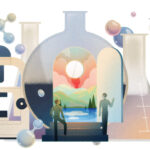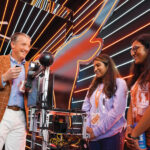The Need For Speed
In 10 years, Jay Boisseau has taken UT from supercomputing minor player to national powerhouse. Now he wants to use Texas’ latest machine to tackle society’s biggest problems.

Drugs designed for specific patients. Individually customized heart surgeries. Famines predicted, food shortages alleviated, and weather reports actually proven accurate. These ideas aren’t science fiction. Increasingly they are the kinds of social, medical, and everyday problems that Jay Boisseau, director of UT’s Texas Advanced Computing Center, is working to solve.
It’s an indelible feature of modern academia that the scale and quality of scientific research depends not only on the brain of the scientist, but also on the power and usability of her supercomputer. Scientists still make observations, and they still design and execute experiments to test hypotheses. But since we know enough about the mathematical equations that govern our world, and because we have tools capable of solving those equations like never before, computation has become a scientific realm all its own.
Recent advances have allowed those with access to the best machines to do exponentially more accurate and ambitious science than their peers, launching a worldwide race to build ever more muscular systems. In 2006, TACC stunned the supercomputing community by winning the largest National Science Foundation award in UT’s history to deploy the world’s most advanced public system. This spring, UT competed once again in a national competition for funding to build the latest and greatest. Every major high-performance computing center in the country submitted a bid; this September, the NSF announced UT once again had won. The four-year, $51.5 million grant to build Stampede will boost UT’s computing power twentyfold and complete a 10-year transformation from supercomputing also-ran to one of the preeminent advanced computing centers anywhere.
“With all that we have done to position ourselves as the best, if we had lost this we would have still been among the best,” says Boisseau, MA ’90, PhD ’96. “But nobody didn’t compete for this system, and we still won.”
Boisseau is the ambitious, charismatic workaholic behind Texas’ astonishing rise. The UT graduate who earned his master’s and PhD in astronomy was hired away from the San Diego Supercomputing Center in 2001 to take over and turn around what was then a meager effort at his alma mater. While the staff was capable and the administration supportive, the equipment was hopelessly behind. Several staffers complained of needing glasses until Boisseau looked at their workstations and realized the problem wasn’t their eyes but their hazy computer screens. His first purchase was 17 new Dell PCs that weren’t all that technologically behind the supercomputer they were running.

In the ensuing months, Boisseau rebooted the center, focusing both on technological savvy and, surprisingly, a kind of customer service. While most of the country’s leading centers were far ahead in horsepower, Boisseau recognized that Texas could make real gains by focusing on how to help researchers get the most out of the machines they did have.
“Ten years ago, there were almost no scientists good at visualization,” Boisseau says. “We made it part of our charge to help scientists realize that if they don’t do good visualization, they may not see the discoveries they just made.”
The center soon found that many researchers preferred working on a less powerful system when they got help with making it work and visualizing the resulting data. Even scientists, it turned out, like dealing with friendly, helpful people.
Boisseau began hiring more PhDs who could help optimize code to run on supercomputers; build software to extract, organize, and store data; improve the actual interface between researcher and system; and operate one of the best visualization labs in the world.
Word started to spread about Texas and its young director. Just as importantly, the news spread within the Austin tech community that something exciting was happening at the J.J. Pickle Research Campus. Boisseau and his colleagues developed partnerships with Dell, Intel, IBM, AMD, and Nvidia. These collaborations are instrumental in developing proposals to build better machines.
“A lot of people know Austin as a high-tech hub, but what’s less known is that Austin is becoming a supercomputing capital of the world,” Boisseau says. “The Dell-TACC relationship may be the best in higher-ed supercomputing in the nation.”
Even as Texas emphasized the support systems around the supercomputers, Boisseau and his colleagues landed ever more powerful hardware. In 2003, Texas deployed its first tera-scale Linux cluster.
Having such a robust supercomputing center affiliated with the campus allowed UT researchers to improve their work, and it started attracting top talent from elsewhere, too. In 2005, Omar Ghattas, a renowned geophysical systems modeler at Carnegie Mellon, visited Texas. Ghattas had been using supercomputers to research earthquakes and ice flows on the nation’s top systems, and when UT began recruiting him, he had heard little about its high-performance computing center.
 “I met Jay on my visit and was convinced the guy was going to do amazing things,” Ghattas remembers. “He was like a Category 5 hurricane—the guy was a force of nature. Within a half hour of meeting him, I knew he had a plan, and that we were going to be in the big time.”
“I met Jay on my visit and was convinced the guy was going to do amazing things,” Ghattas remembers. “He was like a Category 5 hurricane—the guy was a force of nature. Within a half hour of meeting him, I knew he had a plan, and that we were going to be in the big time.”
In the 10 years Boisseau has led the Texas Advanced Computing Center, he has indeed made it big time. The center’s budget, staff, and computing power have all increased dramatically—and that’s not including the order-of-magnitude jump in power that Stampede will unleash. All told, Boisseau and his team have been responsible for some $200 million in federal funding to UT in the last decade, and those numbers show no signs of slowing.
When he’s not at his office at the Pickle Research Center or putting in weeklong all-nighters to finalize grant proposals, Boisseau frequents coffee shops near his downtown condo. He secludes himself there for hours to complete administrative work he tries to protect his research staff from having to do. And he answers the hundreds of emails he receives daily.
Boisseau revels in Austin’s live-music scene and is a huge fan of the SXSW festival. He drives a silver Camaro and brags that 60 percent of its parts were made in America. On the weekends, he prefers Mulberry for Saturday-morning pancakes with his daughter and dive bars for late-night beers with friends. On a recent trip to Dirty Bill’s, Boisseau whipped out his iPhone, cued up an app to access the bar’s jukebox remotely, and selected songs by Bel Biv Devoe, Patsy Cline, and Arrested Development. If he weren’t the director of an advanced computer center, he says, he’d make movies or open a bar.
Recently, Boisseau has started reaching out more actively across disciplines to help even researchers in the arts and humanities find ways to use supercomputers. The center is collaborating with the art department to host an exhibit featuring high-definition multimedia art at the visualization lab, and Boisseau sees potential for more partnerships.
“I’ve always loved the University’s saying, ‘What starts here changes the world,’” Boissseau says, “so we made our tagline, ‘Powering discoveries that change the world.’”
Now that the center has not only caught up with the nation’s elite supercomputing centers but actually surpassed most of them, Boisseau acknowledges that it could be tough to keep his staff hungry and motivated. His goal, he says, is to shift the focus of the center from catching the big boys to improving the impact of the science its users do.
In the past few years alone, the center has allocated system resources to work on finding the Columbia space shuttle remains, modeling the path of Hurricane Katrina, and projecting everything from the spread of swine flu to the effects of the Deepwater Horizon oil spill. The medical applications of supercomputing are only just being explored, and with the new power provided by Stampede, Texas is poised to be on the leading edge.
“We’re never done,” Boisseau says, “not until every hard science problem that matters to society is solved, from disease to food shortage to climate change. And that’s never going to happen.”











No comments
Be the first one to leave a comment.